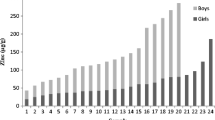Abstract
The analysis of recently grown hair for zinc provides a biomarker of recent zinc status. Seasonal variation of zinc in hair has been demonstrated in children. The aim of this study was to investigate whether on a month-by-month basis there is a seasonal variation in hair zinc concentration in an apparently well-nourished adult population in New Zealand. It was hypothesized that increased hours of daylight would be associated with an increase in zinc concentration in hair. Thirty-four subjects (20 F, 14 M) aged 18–54 yr had occipital hair sampled at monthly intervals between June and December. Food variety was assessed by questionnaire. After thorough washing of the hair followed by nitric acid digestion, zinc was determined by flame atomic absorption spectrometry (FAAS) with special attention to the inclusion of blanks, internal and international standards, and reduction of contamination in each sample run. Analyses between two laboratories confirmed that two FAAS instruments were giving the same reading. No seasonal variation in hair zinc concentration was found. Reported dietary variety, ethnicity, gender, and hair color were unrelated to hair zinc concentrations in this population. This study adds to evidence that will help define the role of hair zinc in determining recent zinc status.
Similar content being viewed by others
References
M. Umeta, C. West, J. Haidar, P. Deurenberg, and J. Hautvast, Zinc supplementation and stunted infants in Ethiopia: a randomised controlled study, Lancet 355, 2021–2026 (2000).
A. Cavdar, Analysis of zinc (serum, plasma, erythrocyte and hair zinc) and its relation to nutrition in pregnant Turkish women: a review of cross-sectional and longitudinal studies, J. Trace Elements Exp. Med. 13, 63–71 (2000).
T. Tamura and R. Goldenberg, Zinc nutriture and pregnancy outcome, Nutr. Res. 16, 139–181 (1996).
H. Sanstead, Zinc: growth, development and function, J. Trace Elements Exp. Med. 13, 41–49 (2000).
J. Rosado, P. Lopez, E. Munoz, H. Martinez, and L. Allen, Zinc supplementation reduced morbidity, but neither zinc nor iron supplementation affected growth or body composition of Mexican preschoolers, Am. J. Clin. Nutr. 65, 13–19 (1997).
R. Kay, C. Tasman-Jones, J. Pybus, R. Whiting, and H. Black, A syndrome of acute zinc deficiency during parenteral alimentation in man, Ann. Surg. 183, 331–340 (1976).
R. Shamberger, Validity of hair mineral testing. Biol. Trace Elem. Res. 87, 1–28 (2002).
M. Hambidge, Human zinc deficiency, J Nutr. 130, 1344S-1349S (2000).
J. Greger, M. Higgins, R. Abernathy, A. Kirksey, M. De Corso, and P. Baligar, Nutriitonal status of adolescent girls in regard to zinc, copper and iron, Am. J. Clin. Nutr. 31, 269–275 (1978).
L. McBean, M. Mahbudji, G. Reinhold, and J. Halsted, Correlation of zinc concentrations in human plasma and hair, Am. J. Clin. Nutr. 24, 506–509 (1971).
W. Strain, L. Steadman, C. Lankau, W. Berliner, and W. Pories, Analysis of zinc levels in hair for the diagnosis of zinc deficiency in man, J. Lab. Clin. Med. 68, 244–249 (1966).
R. Gibson, E. Ferguson, P. Vanderkooy, and A. MacDonald, Seasonal variations in hair zinc concentrations in Canadian and African children, Sci. Total Environ. 84, 291–298 (1989).
R. Gibson and M. De Wolfe, Copper, zinc, manganese, vanadium, and iodine concentrations in the hair of Canadian low birth weight neonates, Am. J. Clin. Nutr. 32, 1728–1733 (1979).
R. Gibson and I. Gibson, The interpretation of human hair trace element concentrations, Sci. Total Environ. 39, 93–101 (1984).
E. Ferguson, R. Gibson, C. Opare-Obisaw, S. Ounpuu, L. Thompson, and J. Lehrfeld, The zinc nutriture of preschool children living in two African countries, J. Nutr. 123, 1487–1496 (1993).
B. Welz and M. Sperling, Atomic Absorption Spectrometry, Wiley-VCH Weinheim (Germany) (1999).
G. Savige, B. Hsu-hage, and M. Wahlqvist, Food variety as nutritional therapy. Curr. Ther. 38, 57–69 (1997).
S. Seidel, R. Kreutzer, D. Smith, S. McNeel, and D. Gilliss, Assessment of commercial laboratories performing hair mineral analysis, JAMA 285, 67–72 (2001).
Author information
Authors and Affiliations
Rights and permissions
About this article
Cite this article
Rush, E., Li, L., Chandu, V. et al. Hair zinc concentrations not subject to seasonal variation in adults in New Zealand. Biol Trace Elem Res 95, 193–201 (2003). https://doi.org/10.1385/BTER:95:3:193
Received:
Accepted:
Issue Date:
DOI: https://doi.org/10.1385/BTER:95:3:193




